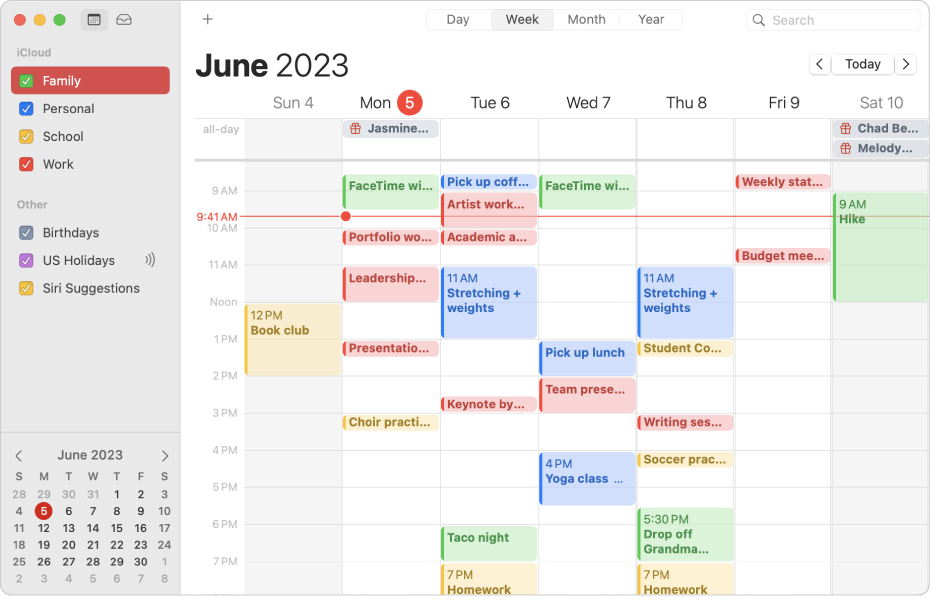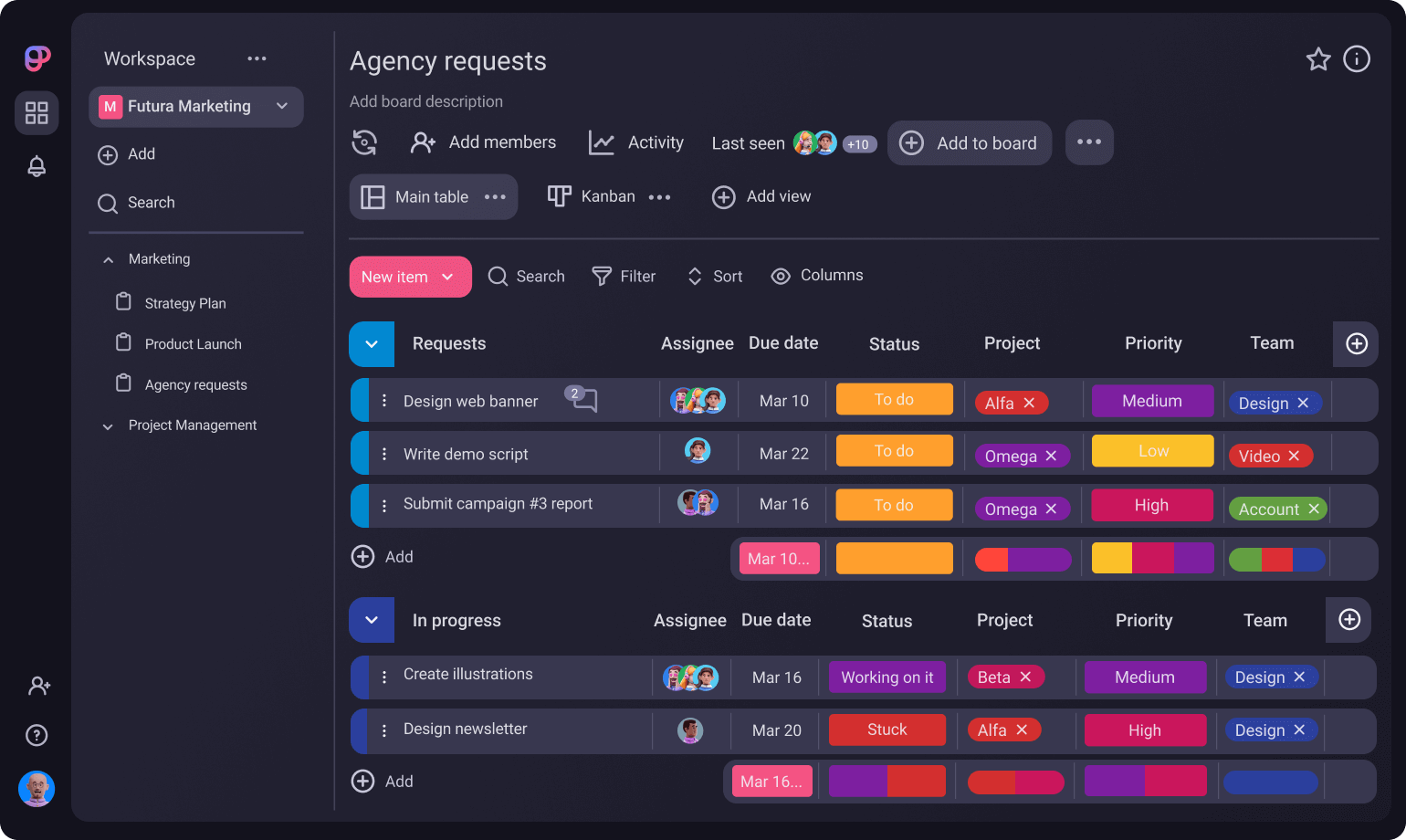Time management can be a challenging feat to accomplish for leaders who manage multiple teams in their organization. This can lead to something called “poor calendar hygiene,” which happens when leaders find themselves struggling to find time for deep work, juggling responsibilities that conflict with each other, and trudging through back to back meetings with no breaks in between. Poor calendar hygiene can often have a trickle-down effect, where the same issues that affect leadership also affect the employees they manage.
In this article from GoRemotely, author Nicolas Zenker notes that “the average employee is only productive for 2 hours and 53 minutes per day.” With that staggering stat in mind, it’s no wonder that effective leaders turn to tools like calendar apps to help them be more productive.
What are calendar apps?
These hidden productivity gems are tools designed to help you efficiently organize your busy schedules, be they personal or professional, all in an online calendar. Because these apps can often be deployed org-wide, they’re an ideal solution for leaders that also want to ensure their teams are making the most of their time.
What to look for in a calendar app
One thing to keep in mind when looking for a calendar app for your organization, is that not all calendar apps are made equal. There are several calendar apps on the market that offer different features and functionality. With that in mind, here are the main things to look for when selecting a calendar app:
1. Security
When working in tech, security is the A1 thing to look for in external tools or apps. The reason this is so important for calendar apps is that meetings inherently have sensitive information attached to them. The type of information can range from contact and location data to private meeting links and financial info, hence why it’s so important to be selective when it comes to calendar apps. Something to look for right off the bat is whether the calendar app company is well established in their field with a robust existing following/audience/user set. Another thing to look out for is a dedicated security page on their website, outlining the systems they have in place to continuously protect your organization’s data and information.
2. Compatibility
The last thing you want is to commit to a calendar app, only to find out it doesn’t connect with any of the tools your organization already uses in its workflow. This is why you’ll want to look out for an integrations section when doing your research on time management software. Ensuring the time management software you choose for your organization is connective and compatible with your existing workflow is essential.
3. Collaboration
Calendar apps that don’t facilitate collaboration among team members are essentially counterintuitive. While they’re meant to help you and your team be more efficient, part of that efficiency should be in making a platform for your team to come together and work together seamlessly. As an example, some calendar apps have collaborative meeting agendas built in to every event to help foster collaboration org-wide.
4. AI functionality
In this day and age, it’s clear that AI is here to stay. Interestingly, it happens to be a great indicator for innovation and modernity in companies. It’s no secret that AI has proven super effective at delivering curated content in a fraction of the time it would take a human. As an example, there are select calendar apps on the market that are capable of generating fully customized AI meeting agendas by simply pulling basic information from the calendar event, such as the purpose of the meeting, its title, and the expected attendees.
5. Customizable features
Speaking of fully customized, the next thing you’re going to look out for is how well the calendar app can accommodate any customizations you’d like to make to its interface. This customizability can vary from something simple like supporting dark or light mode and color coding events, to more complicated custom features like time saving automations. Dealing with a rigid, non-custom calendar app can create blockers for your team, so this is a research step you definitely don’t want to skip on.
6. Ease of use
Adopting a new tool across your organization can be challenging, but one of the best ways to avoid those challenges is by choosing a calendar app that’s intuitive and easy to use. This is where you’ll want to reflect on how your team actually works on a day to day basis, and picture how this new app you’re looking at will fit into their daily workflow. A great resource to check before committing is a reputable review site like G2.
The top calendar apps of 2024
1. Fellow
Fellow is a top contender when it comes to calendar apps. It comes built in with AI functionality to help your team have fewer, shorter, more effective meetings. The way it does this is by syncing with your organization’s internal calendar system, and then its AI Meeting Copilot can automatically join your meeting calls to record, transcribe, summarize, and share your meeting notes with attendees. It then brings all three elements together in each calendar event. Fellow is designed to centralize everything meeting related, like analytics, action items, feedback, and more. It integrates with over 50 productivity tools, and has an extensive library of over 500 meeting templates that you can easily add to any calendar event. Not to mention the fact that Fellow is SOC2 certified, so you can rest easy knowing your organization’s data is secure and continuously being protected.

Because it integrates with your calendar, like Outlook or Gmail, Fellow can easily act as your copilot for all of your meetings. By having your meeting recording, transcript, and summary all in one place, you and your team can start having fewer, shorter, more effective meetings.
G2 Rating: 4.7/5
{{blog-insert-calendar="/blog-inserts"}}
2. Monday.com
This calendar widget enables its users to track tasks according to their corresponding projects. People who use Monday can view all their upcoming tasks that require immediate attention without being distracted by the ones that don’t. By creating a calendar that only shows exactly what you want to see, you can stay focused in your workflow. It’s customizable between a weekly or monthly view, and respectively customizable between viewing all tasks or only the outstanding ones.

Leveraging Monday.com is easy for many different workflows. You can expect a pricing plan ranging from the basic $11 per seat option to a higher costing enterprise plan.
G2 Rating: 4.7/5
3. Vyte
If you’re looking for a scheduling app that’s intended to automate the process of booking 1-1 and group meetings, Vyte is a good option. It works by letting people share any upcoming availabilities they might have via their online calendars.

To start, Vyte has a free trial of its pro features that lasts two full weeks to give you an idea if its functionality is right for you and your team.
G2 Rating: 4.5/5
4. Fantastical
The main value prop from Fantastical is making it easy for you to focus. It boasts very customizable views ranging from day-by-day to quarter and annual views. You can also take advantage of templates for both events and tasks, as well as the ability to attach photos and files.

The ability to only see what you want to see is super advantageous, and allows you to table distractions and manage your time as best as possible. Fantastical has both free and paid subscription options for you to check out.
G2 Rating: 4.4/5
5. Zoho
With the ability to build calendar events, invite your teammates into your calendars, manage group calendars, and more, Zoho is an excellent calendar app option. It’s designed with facilitating workplace time management in mind.

Zoho enables you to create calendars that can be shared across your team to help keep them organized and on track. You also have the ability to build group calendars designed for your colleagues, or take an existing calendar and share it with whichever folks you like.
G2 Rating: 4.4/5
6. Microsoft Outlook Calendar
Below you can see the calendar scheduling element of Microsoft outlook. This calendar app is built to sync with your email, contacts, as well as other features. To use Microsoft Outlook Calendar, simply click on a time slot within the calendar itself; Then you can start building out appointments and events as you like. It also enables you to organize other meetings, take a look at group schedules, and share other calendars you’re connected to.

It’s worth noting that in order to unlock some additional features or storage space, you’ll be prompted to upgrade your subscription. Otherwise, using Microsoft Outlook Calendar is completely free.
G2 Rating: N/A
7. Apple Calendar
If you’ve used an iOS device in the past 10 years, chances are you’ll recognize this calendar app. Apple Calendar has customizable functionality in that you can built separate calendars based on your individual needs, i.e: one for work, family, personal responsibilities, etc.

The great thing about Apple Calendar, if you’re an iOS user, is that it’s totally free and comes built in to most Apple tech at no extra cost.
G2 Rating: N/A
8. Calendly
This meeting scheduling calendar is ideal for those who have to deal mainly with external clients or users. Calendly is frequently used by sales-based organizations or recruitment agencies. The reason it’s so popular with these types of organizations is it can share your meeting availabilities with the click of a link, without sharing the info from the existing events on your calendar.

You can choose from either a free or essential plan ($8 per month, per seat). You can also reach out to the team at Calendly directly if you need to configure a plan for larger teams.
G2 Rating: 4.7/5
9. SavvyCal
Sometimes users are looking for calendar apps that absolve the recipients of the scheduling link of the responsibility of scheduling the meeting as much as possible. Savvycal was designed to make meeting booking easier between parties, and does so by allowing recipients of your shared calendar to overlay their own calendar on top, revealing the most ideal meeting times.

This calendar app offers free sign up and has additional paid functionality that you can choose to upgrade to if necessary.
G2 Rating: 4.7/5
10. Plaky
Plaky is an ideal calendar app for teams dealing with content. It’s technically task management software that has calendar features built in, and is meant to help users manage tasks and teams visually. It also offers some customizable functionality such as labeling and color coding, as well as the ability to assign tasks to individuals or entire groups of people.

It’s completely free to try, and allows you to modify your calendar as the needs of your team change.
G2 Rating: N/A
11. Pensight
This calendar app was built with creators in mind. Creators often have to contend with scheduling appointments for things like courses and coaching services, and tie in other important elements like video calls and payment processing. Pensight helps creators being all those elements into one calendar app.

Creators can easily set their own recurring availability, and connect their internal calendar apps of choice, like Google or Outlook, to avoid any conflicts in scheduling. This way, clients can pay for and schedule appointments from creators directly from social platforms. Users can test drive the pro features for 7 days before choosing which subscription works best for them.
G2 Rating: 4.4/5
12. Asana
Despite it being a task and project management tool, it’s worth noting Asana in this list. Because it’s designed to help people stay on top of their tasks, projects, and deadlines, Asana has a calendar view which can be a really helpful visual aid for task and project scheduling. These elements can then be viewed either by due date within the calendar itself, or sorted and filtered in the format of a list.

Asana offers a free basic plan, as well as a premium plan for $10.99 per month, and a business plan at $24.99 per user per month. As expected, each plan tier unlocks more features and functionality.
G2 Rating: 4.3/5
Tips for effective calendar use
Using calendar apps is a great step in the direction of productivity, but it's important to ensure you and your team are using them effectively to get the most out of the tool. Tips for effective calendar use include but aren’t limited to:
Setting reminders
If your calendar is booked from end to end, it can be easy for your team to miss certain events if they don't have reminders or notifications set up in your calendar app. Setting up pre-event reminders to ping teammates before they start will help keep everyone on track and arrive to each event ready to contribute and engage. Reminders don't have to only notify about when the event is about to start, some calendar apps can remind you and your team to do other things like fill out meeting agendas in advance, or contribute to specific sections of the agenda.
Scheduling buffer time
It's important to leave room to breathe in between your calendar events. This can be challenging for leaders and their teams, especially if they're in back-to-back meetings most days of the week. A great way to automatically get more time back in everyone's calendars is by using a calendar app with built in functionality for meeting best practices. Fellow, for example, comes with a set of meeting guidelines that connect to your calendar to prompt meeting organizers to book meetings with enough time in advance so attendees can show up prepared.
Blocking time for tasks
While having time in between calendar events can help you show up more prepared and ready to engage, what happens when calendars are fully booked with only short breaks in between each block? It can be difficult to execute tasks or focus on projects with only 20 or 30 minutes to devote to actually working. This is why blocking time for tasks is essential. A great way to facilitate this from a leadership perspective is setting a "no meeting day" across your organization to make time for deep work and execution.
Color-coding categories
One great functionality that most calendar apps have built in is the ability to color code different types of events in your team's calendars. This is especially helpful if you are syncing multiple calendars into one place, and will help everyone be able to differentiate different tasks and events by category at a glance. Be sure to choose colors that contrast enough so you can easily tell which category is which, without being overwhelming every time someone looks at their calendar.
Centralizing your calendars
Color-coding categories goes hand in hand with centralizing multiple calendars into one synchronized place. The reason leaders often have multiple calendars that are separate from one another is to be able to track personal commitments without having them on the same calendar as their work ones. The beauty of centralizing your calendars is being able to keep your personal and work calendars separate but still in one view, so you don't have to use multiple tools depending on which calendar you want to see.
Conducting regular reviews
Auditing your calendar regularly is an excellent best practice to promote efficiency and productivity. It's all too easy for teams to set recurring meetings that repeat every week ad infinitum, and end up wasting an hour of your time every week just because it's become a muscle memory to do so. Conducting regular calendar reviews enables your team to look at the events they attend critically, ensuring they're making the most of their valuable time week after week.
Syncing your calendars across multiple devices
Having your calendar synced to more places than just your PC or laptop is an ultimate productivity hack. As a leader who cares about operational efficiency, it's not uncommon to have to step away for your desktop to take care of business, making it easy to accidentally miss important events in the calendar. Having your calendar app synced to your smart phone or tablet makes it easy to take your calendar with you wherever you go.
Conclusion
When finding the right calendar app for you and your team, there are a plethora of choices on the market. The best one will depend on what you and your organization's needs are. Remember to look for a calendar app that has security, compatibility, collaboration, and AI powered features at the forefront of its user interface. If you're looking for a calendar app that can do more than just help your teammates find the right time to meet with others, Fellow is the top contender. It's the only software that can actually help organizations get more time back in their calendars using AI powered features, and built in meeting guidelines to have fewer, shorter, more effective meetings.
Don't let unproductive meetings slow you down
See the impact of fewer, shorter meetings, increased accountability, and enhanced productivity with Fellow.
Get started with Fellow today.webp)
.webp)


%20(1).webp)
